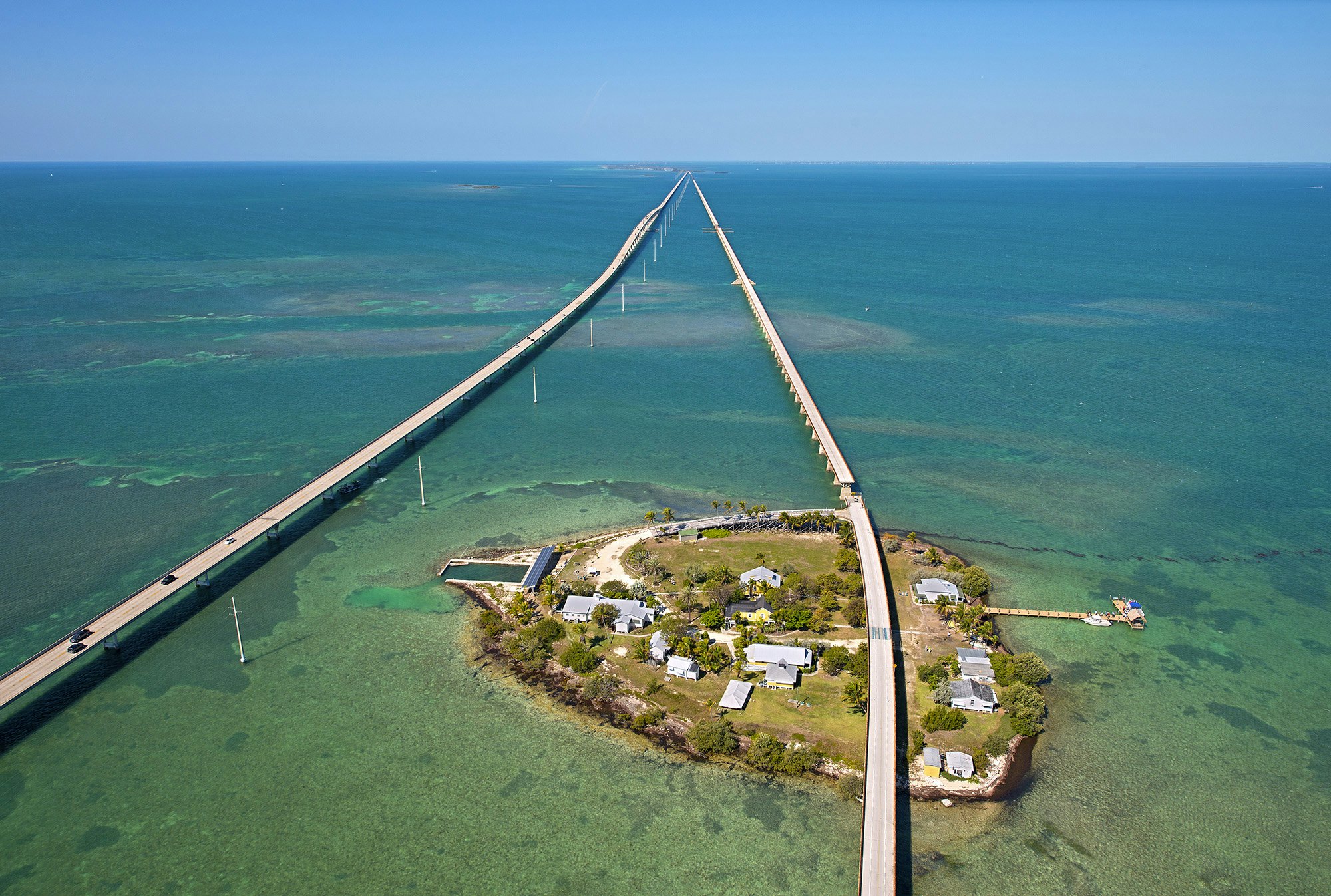Florida's iconic 100-year-old Seven Mile Bridge reopens to cyclists and walkers

Mar 23, 2022 • 4 min read

Fresh off a multimillion-dollar facelift, a Florida landmark is welcoming back cyclists and pedestrians for sunrises, sunsets and one of best photo ops in the state © Andy Newman / Florida Keys News Bureau / HO
After a years-long $44 million restoration, Florida's landmark Old Seven Mile Bridge is welcoming runners, cyclists and pedestrians once again, for sunrises, sunsets, and one of best photo ops in the state.
Running parallel to the Florida Overseas Highway in the Middle Keys and linking the city of Marathon with Pigeon Key, a tiny island below the bridge, Old Seven – as it's known locally – was originally built in the early 1900s as part of Henry Flagler’s Florida Keys Over-Sea Railroad, which connected the islands to the mainland for the first time. In 1938, the bridge was converted for automobile use, and in the 1980s it evolved once again, becoming a hub for outdoor pursuits of all kinds.
More recently, however, the century-old 2.2-mile span began showing its age, and by 2016 there were reports of crumbled decking and rusted and broken railings, per the Miami Herald. Renovations began the following year, kicking off phase one of a 30-year, $77 million plan to restore and maintain the iconic structure.

To that end, changes were implemented to make Old Seven safer for recreational use, with improvements including structural steel and bridge joint system repairs, as well as new decking and handrails for pedestrians and cyclists.
“What made the project challenging was that it is a historic bridge, and that we had to restore the bridge to the same aesthetic fabric as the original,” project manager Tony Sabbag, a Florida Department of Transportation contractor, said in a press release.
The bridge reopened in mid-January, several months ahead of schedule, and the crowds are already returning. “It really is more of a linear park, where people can come out and recreate and go biking, walking, cycling, running, take a look at all the marine resources whether it be spotting turtles, sharks, rays, tarpon,” Kelly McKinnon, executive director of the Pigeon Key Foundation, said in the press release. “It's just an unbelievable experience for individuals and families to come out and take advantage of."

In addition to the recreational opportunities provided by the bridge, Pigeon Key is an attraction in its own right. Once home to 400 workers on Flagler’s railroad, it now offers snorkeling, bird-watching, fishing off the pier and a small museum with artifacts detailing the island’s history – and by spring, a new 60-passenger tram is slated to be up and running for easy access.
“As you come onto Pigeon Key, you really do step back in time,” McKinnon said. “It's fantastic to walk around, see these original structures, be on the same ground that these men 100-plus years ago were on.”
Both Pigeon Key and the bridge itself are listed on the National Register of Historic Places, and their significance has been well established, thanks to the involvement of Henry Flagler. One of the main architects of modern Florida, Flagler recognized the state’s potential as a tourism destination early on, and he was responsible for some of its trailblazing accommodations, including the Hotel Ponce de León in St Augustine and the Breakers in what’s now Palm Beach.

According to the Henry Morrison Flagler Museum, the Standard Oil tycoon began acquiring Florida railroads the 1880s with an eye toward further development, so when the US announced plans for the Panama Canal in 1905, he quickly clocked that extending his Florida East Coast (FEC) Railway from Miami to Key West could prove valuable for trade with Cuba, Latin America and even California to the west.
Still, the engineering challenges involved in that extension were not insignificant – steel and concrete bridges were required to lift almost half of the 156 miles of track over water and marshland, for one – and the project was dubbed “Flagler’s Folly” by the doubters.
But seven years, five hurricanes and a reported $50 million later, the first train on the Over-Sea Railroad rolled into the depot at Key West. The line would operate from January 22, 1912, until Labor Day 1935, when a massive category 5 hurricane demolished the Keys, killing more than 400 people and the railway along with it.
“I was a school teacher then and myself and another teacher were coming back to Key West from Tulane University in New Orleans where we’d taken a course,” Wilhelmina Harvey, a Keys native and then Monroe County Commissioner, reminisced to the Miami Herald in 1982, when the new Seven Mile Bridge was dedicated and the old one retired. “When we got into the FEC depot in Miami, I asked ‘what time is the next train to Key West?’ The man said, ‘Young lady, the last train that has ever gone to Key West left a few days ago. Haven’t you heard, there’s been a hurricane.’”
“I’ll always remember being a passenger on that train traveling north,” Harvey continued. “I can still hear the porter call out in a high voice, ‘Seven Mile Bridge coming up.’ And everybody would leave their seats and we would hang our heads out the windows as much as we could so we could get a look at the beautiful view. It still is beautiful.”
You might also like:
First-time Florida Keys: island hopping along the Overseas Highway
Which Florida Keys island is best for you?
Land the perfect outdoor adventure in the Florida Keys



